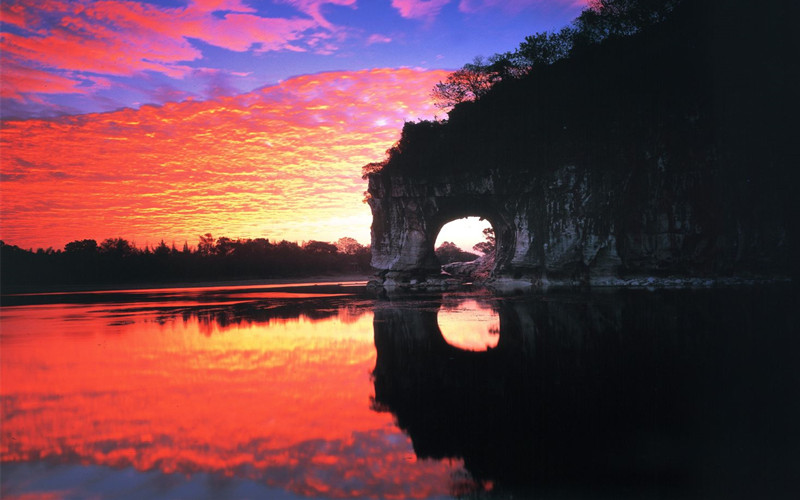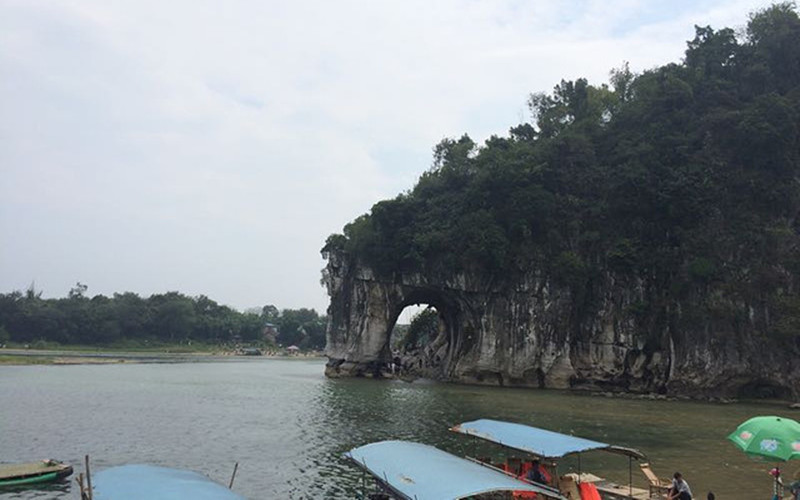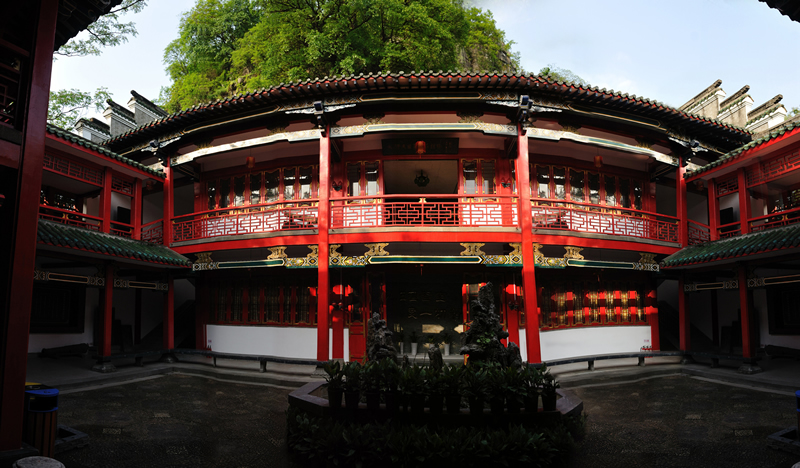Elephant Trunk Hill , is regarded as the city landmark of Guilin which is located in Xiangshan Park,at the confluence of Taohua River and Li River. Also known as " Xiàngbí Shān" 象鼻山 in Chinese, Elephant Trunk Hill is not only the symbol of Guilin but also a famous tourist attraction in Guilin City, Guangxi Zhuang Autonomous Region , Southwest China.

Elephant Trun Hill has been a famous tourism destination since the Tang Dynasty (618 – 907). The hill looks like a giant elephant drinking water from the river. Hence its name. The round opening that would be under the elephant’s trunk is known as Water-Moon Cave because at night the reflection of the moon can be seen through the arch and it looks as if it is under the water and floating on the surface of the water at the same time. Elephant Trunk Hill and Water-Moon Cave are located at the confluence of the Taohua River and the Lijiang River.
What to see?
In the Xiangbishan Park, there are not only many spectacular natural scenes around the hill, but also some ancient constructions, such as Puxian Pagoda, Yunfeng Temple, and Sarira Dagoba.
Water Moon Cave
Water Moon Cave is a semicircular cave between the elephant's legs and trunk. At night, the cave and its reflection together form a bright moon on the river. Although Guilin is studded with hills and caves, it is still unbelievable to see such a cave through which a river can flow. The cave is not very large, but there are more than 50 inscriptions on the wall, with the earliest one dating from the Song Dynasty (960 – 1279).
There is another cave on the hillside. Because of its special location, it is taken as the eyes of Elephant Trunk Hill. And there is an old story that circulates among the Guilin people. It is said that Elephant Trunk Hill is the embodiment of a God Elephant, who used to be the mount of the Emperor of Heaven. It was separated from the Emperor in a war and stranded in Guilin with severe wounds. A local couple saved its life and took good care of it. This animal fell in love with the life there and decided not to return to the heavenly palace. The Emperor bestowed a pagoda to help it suppress evils and protect people. Since then, it never left this place and at last became Elephant Trunk Hill. Puxian Pagoda on the top is said to be the bestowed one.

Yunfeng Temple
Yunfeng Temple, on the southwest slope of the Elephant Trunk Hill, is one of the famous ancient temples of Guilin. It was once the dwelling place of Monk Jianzhen, an eminent monk of the Tang Dynasty, crossing over to Japan six times to spread Buddhist doctrines and help regularize monks' behavior. This scenic area was once the frontline of the Taiping Rebellion (1851 – 1864), a mass civil war in China. The second floor of the temple serves as an exhibition gallery, reviewing this history with historical relics like battle flags, weapons, and cannonballs.

Puxian Pagoda
This brick tower was built in the Ming Dynasty (1368 – 1644) to worship Samantabahdra, one of the four most reputable Bodhisattvas. There is a line-carved figure of him on the north side of the pagoda. The tower is located on the top of Elephant Trunk Hill, which not only tallies with this story, but also coincides with the fact that Samantabhadra always shows up riding an elephant.

Love Island
This luxuriant island is to the north of the hill in the middle of the Li River, providing the best position to appreciate the scene and take photos. Not only can you admire nearby scenery from there, but you can also enjoy Tunnel Hill and Pagoda Hill in the distance. A hollow cave named Moon Cave on Tunnel Hill is like a moon hanging in the sky. Together with Water Moon Cave of Elephant Trunk Hill, they form the peculiar scenery of 'Two Moons on Li River', with one of them on the water and the other in the sky.
Night Show – 'Legend of Elephant Hill'
This night show is another significant feature of the scenic area. Taking the body of the Elephant Trunk Hill as the projection screen, it uses high-tech means, like hypermedia, lasers, and light, to demonstrate beautiful scenery and the culture of Guilin. There are four sections in the show: Primitive Guilin, Mysterious Village, Phantom Theater, and Legend of God Elephant. It depicts natural scenes like thick banyan tree jungles, the beauty of rivers and mountains, and the living conditions of local ancestors. The stunning laser show in the last section creates a totally different visual spectacle of the hill.
Travel Tips
Add: In Xiangbishan Park, Guilin City,Guangxi Region of Guangxi Region
Opening Hours: 07:00-21:30
Entrance Fee: CNY 55
How to reach: Take bus 2, 16, or 23, and get off at Xiangshan Park Station.
